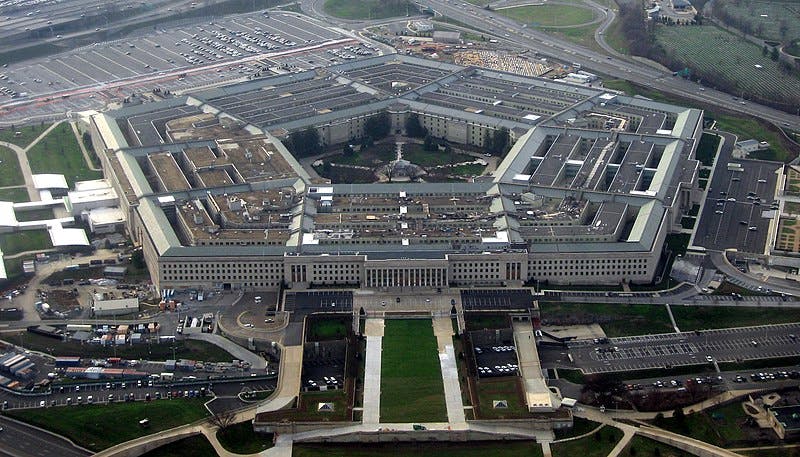Pentagon Audit Showing $1.9 Trillion in Missing Assets Signals Urgent Need Not for More Money but for Reform
The accounting disaster is a reflection of layers of bureaucratic incompetence which are undermining and crippling American national security.

The new audit report about the Department of Defense is another signal that the Pentagon needs reform a lot more than it needs extra money. As the Hill reports, “1,600 auditors combed through DOD’s $3.8 trillion in assets and $4 trillion in liabilities, conducting some 700 site visits.”
Defense, like all government agencies, has to submit to mandatory audits, thanks to reforms passed in the early 1990s. The auditors “found that half of DOD’s assets can’t be accounted for,” the Hill adds.
Think of that statement for a minute. An estimated $1.9 trillion in defense assets can’t be accounted for. How much confidence can we have in a Department of Defense which can’t keep track of trillions of dollars’ worth of equipment and other assets?
The breadth of the Defense Department failure is astounding. There are 29 separate audits in the department. Comptroller Mike McCord says only seven passed. Four were conditional, and 18 audits completely failed.
The accounting disaster is a reflection of layers of bureaucratic incompetence which are undermining and crippling American national security.
Remember, the Chairman of the Joint Chiefs asserted at the beginning of Vladimir Putin’s assault on Ukraine that the Russians would be in Kyiv in four days.
Remember that aid to Ukraine has been slow, bureaucratic, and timid — and has failed to meet the requirements of winning. Remember, too, that there does not seem to be any American strategy for success in Ukraine.
Remember the American intelligence about Taliban efforts in Afghanistan. The American national security system completely underestimated how fast the pro-Western Afghan government would collapse. The Taliban ended up in Kabul many months before our intelligence apparatus projected.
Remember that America has lost every wargame we have played out in a conflict with China.
The Pentagon was opened in 1943 so 26,000 people could manage a global war using manual typewriters, carbon paper, and filing cabinets. The system was so labor intensive that General Walter Bedell Smith ran exercises to see how fast people could find the right documents when they were needed.
Today, Pentagon staff are using laptops, iPads, smart phones, and a host of other devices. The information capacity and speed must be tens of thousands of times faster and more complete than in 1943. In the private sector, that kind of improvement leads to a smaller, more professional workforce. Yet, the Pentagon still employs 26,000 people.
The result is built-in inefficiency. Each underemployed person finds things to do to prove he or she is useful, and that his or her job is important.
We need a new military reform movement comparable to the congressional effort from 1981 to 1986. Those reforms led to dramatic changes in structure which made modern joint combat capabilities possible. That five-year effort produced the Goldwater-Nichols Act, which created the legislative basis for joint activities.
At the time, the senior active duty military leaders unanimously opposed the reforms. In fact, if it had not been for a former Chairman of the Joint Chiefs, David Jones, and a former Army Chief of Staff, Shy Meyer, breaking ranks and supporting profound military reform, we probably could not have passed the legislation. President Reagan and his Defense secretary, Caspar Weinberger, both opposed the Goldwater-Nichols Act.
The key to passing the act was the absolute failure of the Defense Department system in Grenada. The Army and Navy radios could not talk to each other. An Army Captain had to go to a pay phone, use his personal credit card, and call a friend in the Pentagon to report on the inability to communicate.
The failure was so vivid and simple that every senior officer who came to testify against the Goldwater-Nichols Act was forced to defend a system that was utterly incompetent.
I was keenly aware of the need for reform. In January 1981, I joined a group of House and Senate members to create the Military Reform Caucus.
We had been inspired by Senator Hart’s January 1981 article in the Wall Street Journal headlined “The Case for Military Reform.” The caucus was launched when the second-ranking House Republican on the Armed Services Committee, Bill Whitehurst of Virginia, called Mr. Hart to propose a bipartisan effort.
Ultimately, we had 133 members in the Military Reform Caucus. The Center for Strategic and International Studies spent a year with a high-powered team reviewing the reform options.
James Locker III was a key staff leader in this process and wrote a comprehensive book, “Victory on the Potomac,” about the five-year effort.
Four decades later, we need a new Military Reform Caucus. This must be a much broader caucus with an overview of all national security requirements — and an ability to rethink every aspect of national security.
Also, four decades later, the world is amazingly more complex. To be successful, the new reform effort must be broader and deeper than what we did in the 1980s.
Without an intellectual reform of the broken processes, failed bureaucracies, and obsolete assumptions and procedures, it will be impossible to protect America.
We need new ideas, systems, strategies, and approaches far more than we need new money. Our survival is at stake, and Congress has to rise to the challenge.

